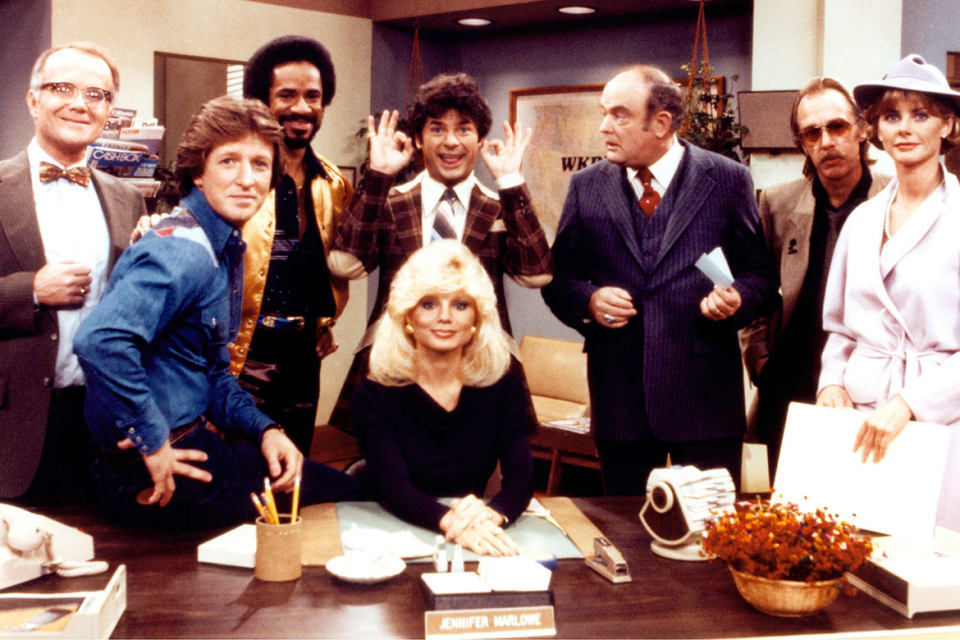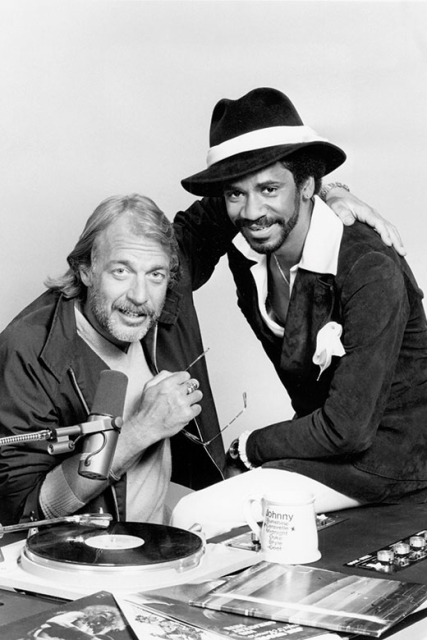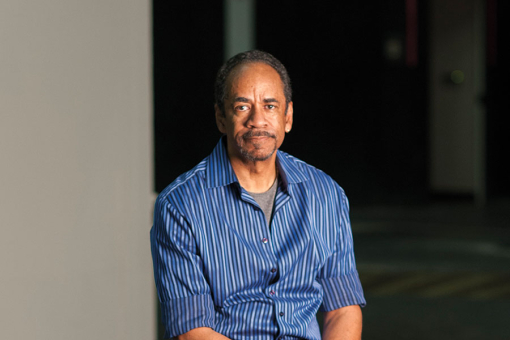It was hardly your average industry meet-and-greet. They were paired as volunteers for the Chamber of Commerce, talking to Chicago-area schoolkids about the dangers of drugs. One day an eighth-grader said, "You guys are so funny. You ought to be a comedy team." So, Tim Reid and Tom Dreesen formed Tim and Tom, the first black-and-white comedy act.
As America struggled through the '70s over issues of race and justice, Reid and Dreesen struggled on the stand-up circuit, reaping cheers and jeers for their trailblazing routines on the racial divide. But the duo faced its own divide and split after five years. Dreesen went on to huge success as a solo act, opening for Sammy Davis, Jr., and Frank Sinatra and appearing regularly on The Tonight Show and the Late Show with David Letterman. Reid turned to television and film, where he has struck down stereotypes as an actor, director, writer and producer.
Even as an unknown, at an audition for the role of dee-jay Venus Flytrap on WKRP in Cincinnati, Reid wouldn't go along to get along. And, as told in the following excerpt from Tim & Tom: An American Comedy in Black and White, that has made all the difference.
The first thing Tim Reid saw when he entered the waiting room was what appeared to be every young Black actor in Hollywood auditioning for the same part — the overnight disc jockey on a new sitcom on CBS. The second thing he saw was a script open to a page that said, "Black man enters room wearing a coat with an ermine collar and a big hat cocked to the side."
"Not again," Reid thought. "I got fired four days ago because I wouldn't do this kind of crap and now this. You're testing me, God, right?" His anger built as he quickly read through the script. "This is insane," he thought. And then he heard somebody call his name.
He knew he shouldn't have done it. He should have told them what they wanted to hear. That it was a wonderful part in what was going to be a great show, and that he was just the one to play it. But as he felt the tension in the room, as he saw the judgmental attitude of the men on the other side of the table — were they trying to scare him? — he couldn't help himself. So what if he was sitting with Grant Tinker, the powerful head of MTM Enterprises, Jay Sandrich, the director who had helped turn The Mary Tyler Moore Show into a television franchise, and Hugh Wilson, the creator of this new show. They had asked him what he thought of the part and he was going to give them an answer.
"The character is a stereotype," he said. "It seems so one-dimensional. And I'm not sure I want to be walking down the street when I'm sixty years old and have somebody refer to me as Venus Flytrap."
"All right, if that's the way you feel," said Sandrich, who, along with Tinker, was shocked by Reid's effrontery. "Let's call in the next guy."
"Wait a minute," said Wilson, in a soft southern accent that sounded like home to Reid. "Give me your view of the part. Tell me how you think this character should be portrayed."
"Look," Reid said, "the black disc jockeys I grew up listening to in the South had larger-than-life personas when they were broadcasting, but when they were off the air they were real people with real lives. They didn't look or act or talk anything like the way they did on the radio."
"I agree with you," Wilson said. "That's what I had in mind for this character, that he's multidimensional, not the same old stereotypical stuff. This is just the pilot, something to get him established. Why don't you read for us? Let's see how you'd do it."
"Hugh told me later that he was the only one who wanted me," Reid says, "but they figured Venus Flytrap was not an important character anyway, so they let him have me. I owe Hugh for that. I owe him for a lot."
On September 18, 1978, a cast that included Gary Sandy, Gordon Jump, Loni Anderson, Howard Hesseman, Richard Sanders, Frank Bonner and Jan Smithers debuted in WKRP in Cincinnati, a show about a struggling radio station that changes its format from easy listening to rock 'n' roll. In the pilot episode's final scene, Venus Flytrap makes his first appearance wearing a purple suit and hat, a full-length white leopard-spotted coat and a towering Afro.
"It's the hour of darkness, children," he says as the closing credits begin to roll, "and Venus is on the rise in Cincinnati. The moon is high [he hits a gong and winces] and so am I. So let's get down, pretty brothers and sisters. Let's prowl and howl. After this word from Shady Hills Rest Home."
"I guess we didn't get away from any stereo types in the pilot, did we?" Reid says with a laugh. But he was on his way now. The show was going to be huge. He could feel it. Who knew where this might lead?
The critics loved WKRP in Cincinnati. "A sitcom perfect storm," one called it. "Brilliant writing, colorful characters, an expert cast." The ratings, though small at first, consis tently increased as the show developed a devoted fan base, and as disc jockeys around the country talked it up as an honest and enjoyable portrayal of local radio stations. The television industry admired the show, too, voting it ten Emmys during its four-year run and the prestigious Humanitas Award for "film and TV writing deemed to promote human dignity, meaning and freedom."
The cast members enjoyed it so much that after work they often went out on the town together and ended up at one of their homes. This was something Reid had never seen in television before and would never see again. "We ate dinners together, we spent weekends together," he says. "When the show was picked up after we made the pilot we all came together and held hands — I think we knew it was going to be important to our careers — and looked at each other as if to say, 'It's never going to be like this again.' I know it's a cliché, but we really were a family."
The only people who didn't seem to care for the show, who never really understood its appeal and got behind it, were the executives at MTM Enterprises, who produced it, and at the network that put it on the air. "We were CBS's bastard child," Reid says. "They just never embraced the show. They didn't even allow us on the MTM lot. We shot at KTLA, a television station in Los Angeles. I think they viewed us as rogue characters with this rogue creator, Hugh Wilson, who were off in our own world."
This front-office discomfort was not hard to understand. On the one hand, WKRP had all the trappings of a typical 1970s sitcom — broadly drawn characters, slapstick comedy situations, snappy one-liners. More than three decades later, its "Turkeys Away" episode — the station director, not realizing turkeys can't fly, drops live birds out of a helicopter over a shopping center as part of a Thanksgiving giveaway, while shoppers run for their lives and the news director describes the scene as if it were the Hindenburg disaster — is widely considered one of the funniest half-hours in the history of television. But the show also had a social agenda that made it extremely daring for its time. Wilson and his staff wrote scripts dealing with war, racism, drug abuse, abortion, homosexuality, abandoned children, union organizing and conniving politicians. At times it seemed as if he was almost daring MTM and CBS to put a stop to it.
The fact that Reid as Venus Flytrap and Howard Hesseman as Dr. Johnny Fever chose their own music for their disc jockey segments, and that much of it was the latest thing in rock 'n' roll, also led the show into uncharted territory. "Howard was into the Rolling Stones and Pink Floyd and I was playing Earth, Wind and Fire and Marvin Gaye," Reid says. "Pretty soon record companies were begging us to play their songs and sending music to our homes. I ended up with thousands of records from all over the world. The irony is that when they finally brought the show out on DVD in 2007, they had to change all the music because they couldn't afford the rights to the songs we'd used."
This cutting-edge approach inevitably led to problems, and occasionally the disconnect between the KTLA soundstage and the executive suite could have been the basis of a sitcom of its own.
"I got a troubling call from CBS today," Grant Tinker told Reid one day after summoning him to his office.
"What is it?" Reid said, wondering what he had done now.
"They said you had slipped the f-word into this week's show."
"The f-word? You've got to be kidding."
"Tim, did you say mamma jamma when you were introducing a song? One of the executives in New York thinks that's a code word for motherf—er."
"Mamma jamma? Grant, that's the name of a song. 'She's a Bad Mamma Jamma.' It's a big hit by Carl Carlton."
"Oh," Tinker said, and both men burst into laughter.
"Do you mean to tell me executives are sitting in a room at Black Rock debating mamma jamma?" Reid asked. "I can just picture it: 'Gee, I don't know, Al. I think mamma jamma could mean motherf—er. What do you think?"' And he and Tinker laughed some more.
But occasionally, the network's worries were more serious.
"Were you wearing the Star of David in one episode?" Tinker asked Reid.
"I wear a lot of jewelry. It's part of the character — open shirts, jewelry. Why?"
"Well, they're trying to sell the show abroad and Jordan has refused to buy it because they think you're wearing a Star of David. They're offended and I'm supposed to ask you to take it off."
"Grant, it's the word 'LOVE' that a jeweler has created around six points. It's a beautiful piece. I wear it all the time. Here, look at it."
"Okay, Tim," Tinker said with a heavy sigh. "I'll see you later."
Then there were the death threats. "I got ten or twenty a year," Reid says. "They always came when I was alone in the broadcast booth with one of the women. Loni Anderson kissed me on the cheek in a Christmas episode and that really set them off. In another show, Jan Smithers and I jumped up and down and hugged each other. I got so much hate mail the network had to increase security for a few days. Things are different now, I guess, but back then a show like ours could have a tremendous impact on the American psyche. Some people found what we were doing very threatening."
Though WKRP in Cincinnati was conceived as a star vehicle for Gordon Jump as the station manager and Gary Sandy as the program director — they were the only ones who received star billing in the opening credits of the first episodes — it quickly developed into an ensemble in which each of the characters played important roles and had episodes built around them. Hesseman as the spaced-out disc jockey; Anderson as the sexy, savvy receptionist; Richard Sanders as the bumbling news director; Smithers as the shy ingenue; and Frank Bonner as the libidinous sales director worked together in a way that led critics to use the word seamless. And tele vision insiders considered it remarkable that during the entire run of the show none of them was ever replaced or marginalized and no major new characters were added.
Reid's portrayal of Venus Flytrap quickly became something of a conspiracy between him and Wilson, two native Southerners who disliked the way people from their region, Black and white, were so often typecast on television and who were determined to do something about it.
"The network doesn't think you're Black enough," Wilson told him early in the first season.
"Not again," Reid said, starting to laugh. "You know it's a hell of a thing to be Black your entire life but not be Black enough for television."
"We can deal with it, Tim," Wilson said. "We can give them what they want and let the character develop, too, show that he's a human being and not just a one-dimensional street guy. Let's talk about you. What are you into? What is there in your life we can use?"
Before long, Reid's character was being portrayed as delving into meditation and herbalism. He was wearing the loose-fitting clothes with the far-eastern look that Reid had begun designing for himself and listening to reggae. He was also shown to be quite conservative on some social issues — against hard drugs and objecting to the sexual content of song lyrics — and worried that he might be losing contact with black culture. He was making it clear, in short, that there were really two Venus Flytraps, the glib on-the-air hipster and the more complicated man underneath. "Hugh began to write the yin and yang into the character," Reid says. "It was a discovery for him as much as it was for me."
The complexity of Venus Flytrap would pay big dividends a number of times, as in "Venus and the Man," an episode during the third season in which, as a favor to the station's cleaning woman, he uses street language to explain the atom to her son, a gang member who wants to drop out of high school. Soon, physics teachers around the country were using clips from the show as a way of demystifying the subject.
"What do you think about Venus having a beard?" Reid asked Wilson one day after filming for the first season began in earnest. "He didn't have one in the pilot, but I think he should."
"Fine," Wilson said.
"How about an earring?" said Loni Anderson, who was listening to their conversation.
"An earring and a beard?" Reid said, thinking it over. "Nobody's ever done that on television before. But why not?"
"You'll need to get your ears pierced," Anderson said. "That's a little extreme, isn't it?"
"Oh, it doesn't hurt, and it's the only way the earring will look authentic."
"There I was again," Reid says, "doing whatever a strong woman told me to do. And, boy, did she lie. It hurt like hell. I felt like they were driving a stick into my head."
For a time it appeared that Reid's suffering may have been in vain when CBS executives called a meeting in New York to discuss the matter. "Hugh Wilson stood by me again," Reid says. "He said, 'Has television come to this? Are we really going to lose ratings because a Black man is wearing a beard and an earring?' Basically, he just insulted them and they probably figured, what the hell, I wasn't going to be around very long anyway."
But they were wrong. Alter just a lew episodes, Reid began getting applause from the studio audience as he came onto the set and by the end of the first season Venus Flytrap had developed a cult following. The candles he lit in the studio and the gong he played, the Bob Marley poster on the wall at a time when the Jamaican reggae star's fame was just beginning to spread in the United States, the clothes, the beard, the earring, the language all combined to make him a cultural touchstone. As the season wound down, it was clear that Reid was due for a big raise, and for the one thing he had yet to receive — an episode built around Venus Flytrap.
"What about it, Hugh?" Reid asked Wilson. "Everybody's had one except me."
"I wrote one for you, but the network isn't sure about it," Wilson said. "It's about Vietnam."
"Vietnam? In a sitcom? Whoa."
"I know. They said they'll let us do it on one condition, that we have military people on the set while we're rehearsing. If they don't like it, it's not going on the air. The season will have to be one episode short."
In "Who Is Gordon Sims?" Venus Flytrap's real name is revealed for the first time. He is shown to be a soldier who, after witnessing Viet Cong prisoners thrown out of a helicopter and a buddy in his platoon intentionally walk into a propeller, goes into shock. Instead of reporting to an army base back home to receive his discharge, he disappears. Though it is clear Sims has served his country honorably, he is officially listed as a deserter.
"We had soldiers and marines sitting in the audience all day watching our every move," Reid says. "And Hugh was smart. He began talking to them, using them as consultants, and asking them what they thought. They really got into it. The network was still nervous, though. We did n't get the final go-ahead to air the show until the day before the final run-through."
The tension on the set as the episode was shot was such that Reid hardly noticed that the studio was filled with more spectators than usual and a number of MTM executives, including Mary Tyler Moore, Tinker's wife, for whom the company was named. After the final scene was shot — Sims appears before a military hearing and is given a reprimand and his discharge — Moore approached him. "You made me cry," she said.
The episode received glowing reviews — "a tour de force performance by Tim Reid," wrote a reviewer for Variety and Wilson was nominated for an Emmy. It was the perfect end to the show's first season and a strong lead-in to the summer reruns when it was discovered by more and more fans. By the first few weeks of its second season, WKRP in Cincinnati often ranked among the top ten in national audience ratings.
As work on WKRP in Cincinnati progressed, Reid found himself becoming closer and closer to Wilson. Their southern backgrounds and their eagerness to move beyond established sitcom boundaries gave them a great deal in common and Reid also saw how much he could learn from Wilson about writing, directing and producing.
But Wilson also had an anarchic streak, an us-against-them mentality that undermined him in his confrontations with network executives. His battles with MTM and CBS over the content of WKRP in Cincinnati and the way the show was shuffled around the network schedule grew increasingly bitter. He and the others involved in the show were particularly upset when, midway through the second season, it was moved from its prized position following M*A*S*H, the top-rated show on tele vision, to an earlier time slot. This led to concern over what was appropriate for a show airing during television's "family hour" and was a harbinger of things to come. During its third and fourth seasons, WKRP in Cincinnati was moved around so often that the cast and crew often didn't know when it was on. This was, they thought, one more indication of how little regard the network had for the show despite its success.
Lacking the diplomatic skills to smooth the show's path, Wilson began feuding with CBS president Robert Daly, even taking shots at an unnamed network executive based on Daly in his scripts. So no one was truly surprised when the show was canceled after its fourth season. "I'm convinced it was killed because Hugh and Bob Daly hated each other," Reid says. "That show should have run for ten years."
The point was proven when, after the cancellation was announced, the final episode was the seventh most watched show of the week and when WKRP in Cincinnati went on to become a huge hit in syndication. "It was the most profitable show MTM ever had," Reid says. "More than The Mary Tyler Moore Show, more than Hill Street Blues, more than any of the rest of them."
To watch Tim Reid's Foundation Interview, click here.
This article originally appeared in emmy magazine issue #1, 2009, under the title, "Meeting Venus."






